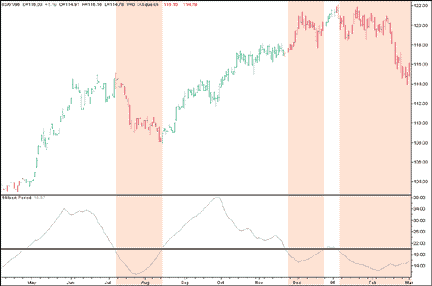TRADING TECHNIQUES
Use A Technique From The World Of Radios To Eliminate Market Noise
Squelch Those Whipsaws
by John F. Ehlers
What's real price movement and what's just noise? Figuring out the difference is vital, and here's an objective measure to help you out.
Hey, good buddy! Ever operate a citizens' band (CB) radio? If you haven't, most CBs are relatively simple devices, usually with three controls: a channel selector, a volume control, and a squelch control. Squelch control is important to the operation of the radio because without it, there would be no way for the radio to distinguish between static noise and a real signal from a transmitter.

FIGURE 1: SQUELCH INDICATOR. With the squelch control set to 20, you can avoid whipsaws by exiting when the dominant cycle falls below 20, here indicated by red bars. Adjust the squelch indicator to be more or less sensitive to whipsaw areas with high-frequency cyclic components.
Such a distinction can also be important to your trading. If you could avoid periods when the market had no clear trend, you'd avoid whipsaws and get cleaner trades. If you could identify periods that were filled with noise and no clear data, you could also switch trading tactics to suit the situation. At the very least, you'd know what situation you faced.
SQUELCH
If you turned the squelch control on a CB radio to maximum, all you'd get is noise. If you turned it all the way down, the noise would go away and would be, in effect, "squelched." At that point, when a voice came on the radio, you would hear a short burst of noise just when the voice you hear stops; that's because there's a momentary delay until the squelch control cuts in again.
The principle here is that the radio receives a range of frequencies in each channel, and the frequencies involving voice waves are located at the lower portion of the frequency spectrum. Noise, on the other hand, is spread across the entire frequency spectrum. By filtering to receive just the low frequencies, the signals in the lower part of the spectrum can be compared with the signals in the higher part of the spectrum. If only noise is present, the power in the two parts of the spectrum -- the lower frequencies and the higher frequencies -- will be roughly equal. But when voice waves are present, the lower spectrum will be larger.
A squelch control is used to compare the two parts of the spectrum and distinguish which part contains relevant voice waves. If the higher-frequency part of the spectrum is about equal to the lower part, then the squelch control can eliminate the signals that constitute simple noise. If a voice -- a real, transmitted signal -- comes over the channel, the squelch allows the signals to pass through to the speakers. This keeps you, the radio listener, from being bothered by static -- noise -- during the time that no voice waves are being received.
John F. Ehlers, Box 1901, Goleta, CA 93116, is an electrical engineer working in electronic research and development and has been a private trader since 1978. He is a pioneer in introducing maximum entropy spectrum analysis to technical traders through his Mesa software. He may be reached at 805 969-6478, or via his Website at https://www.mesa-systems.com.
Excerpted from an article originally published in the September 2000 issue of Technical Analysis of STOCKS & COMMODITIES magazine. All rights reserved. © Copyright 2000, Technical Analysis, Inc.
Return to September 2000 Contents